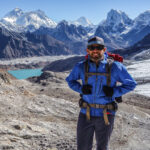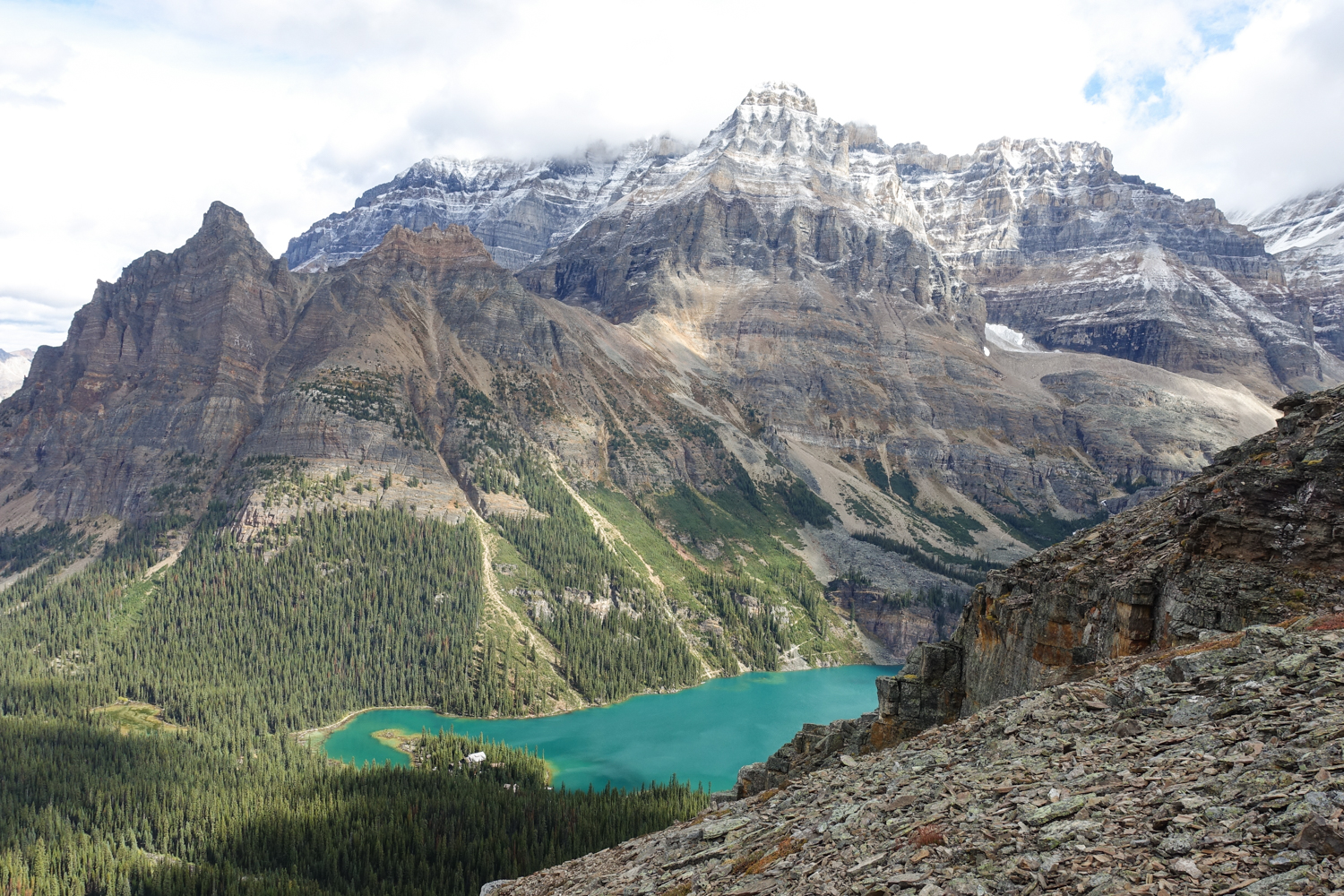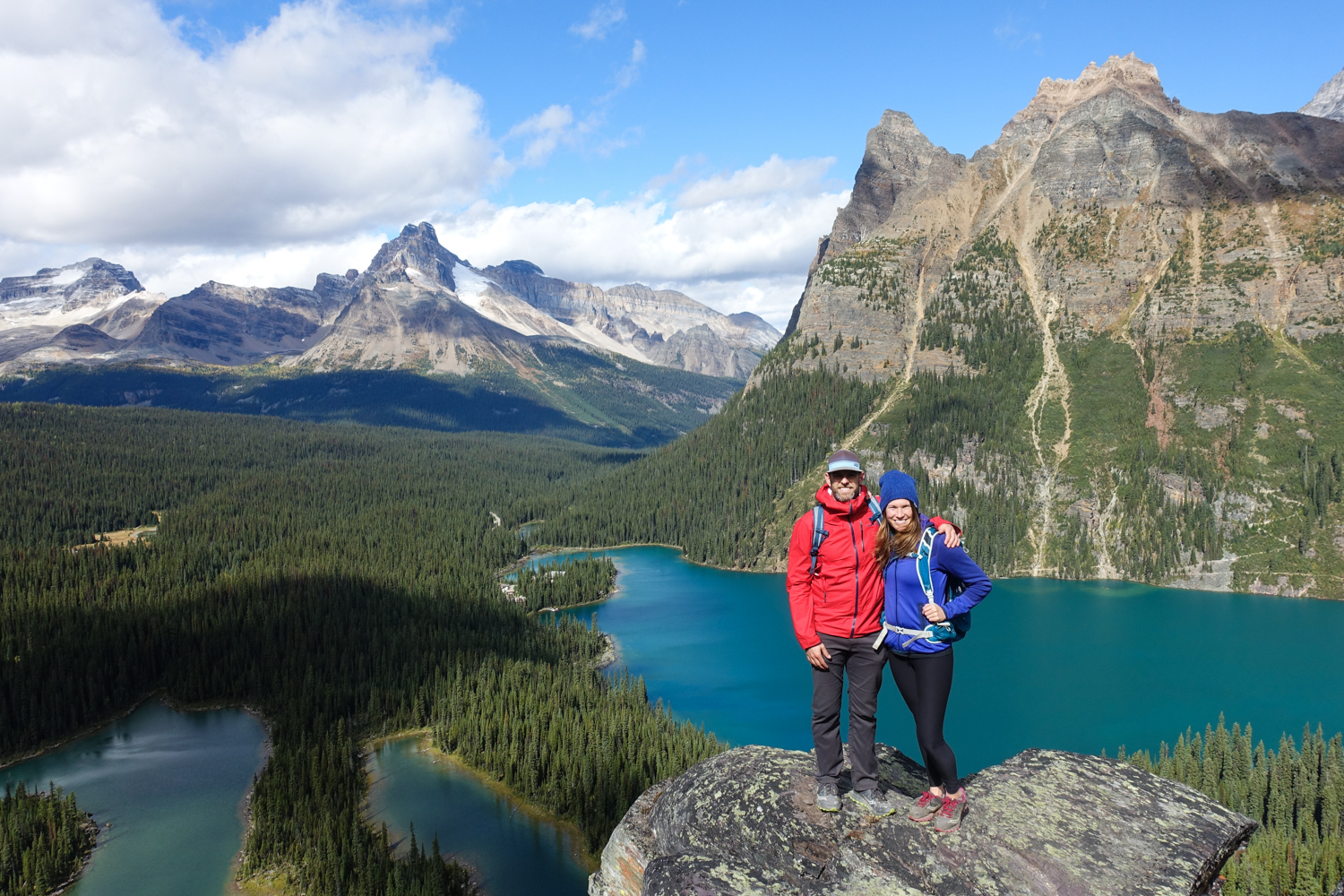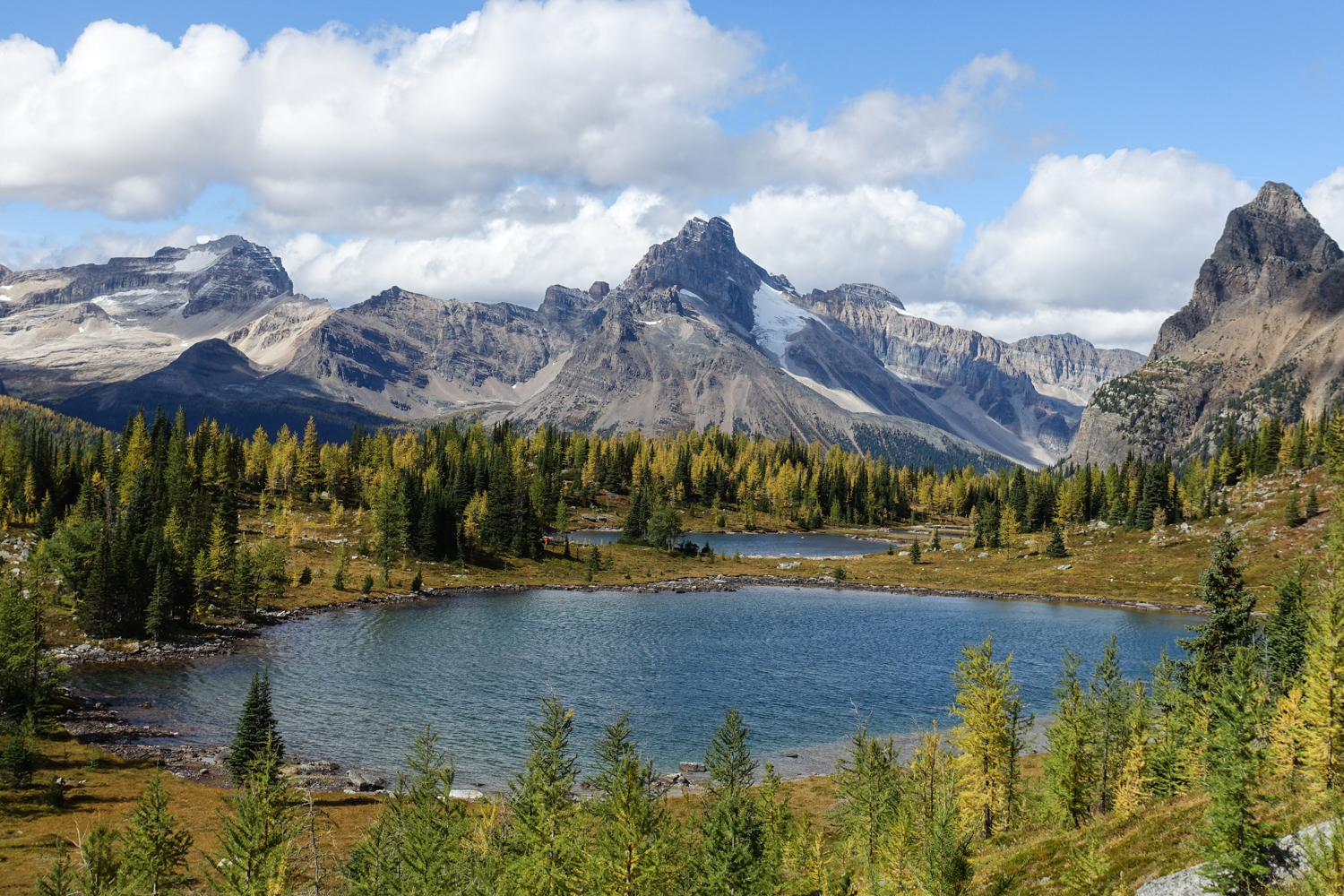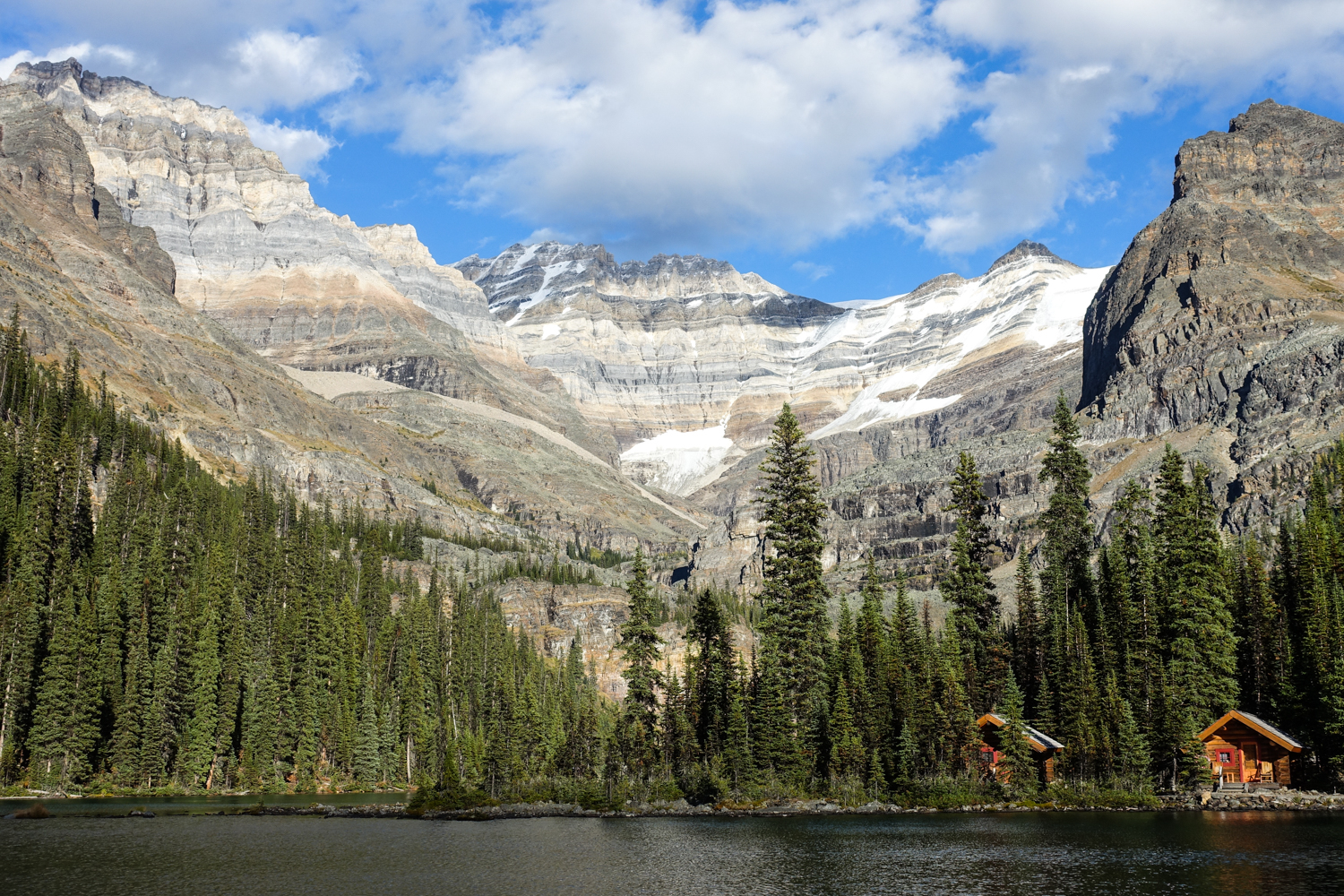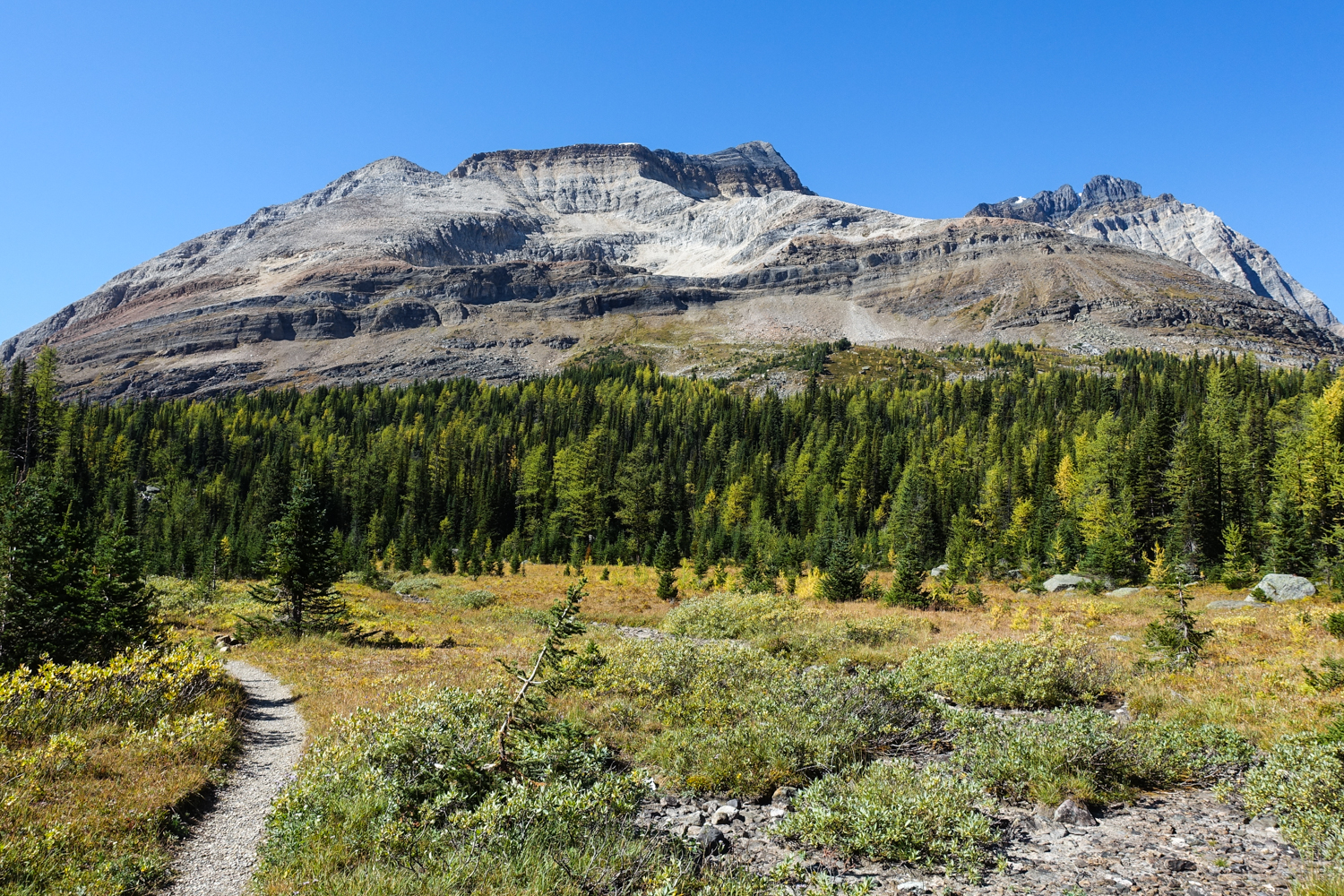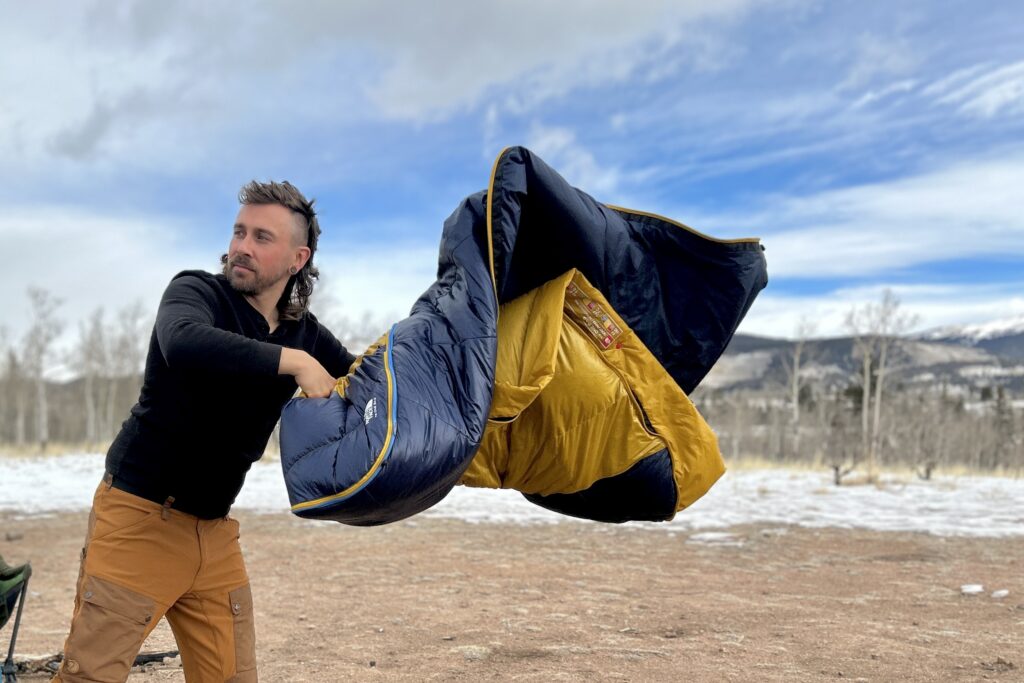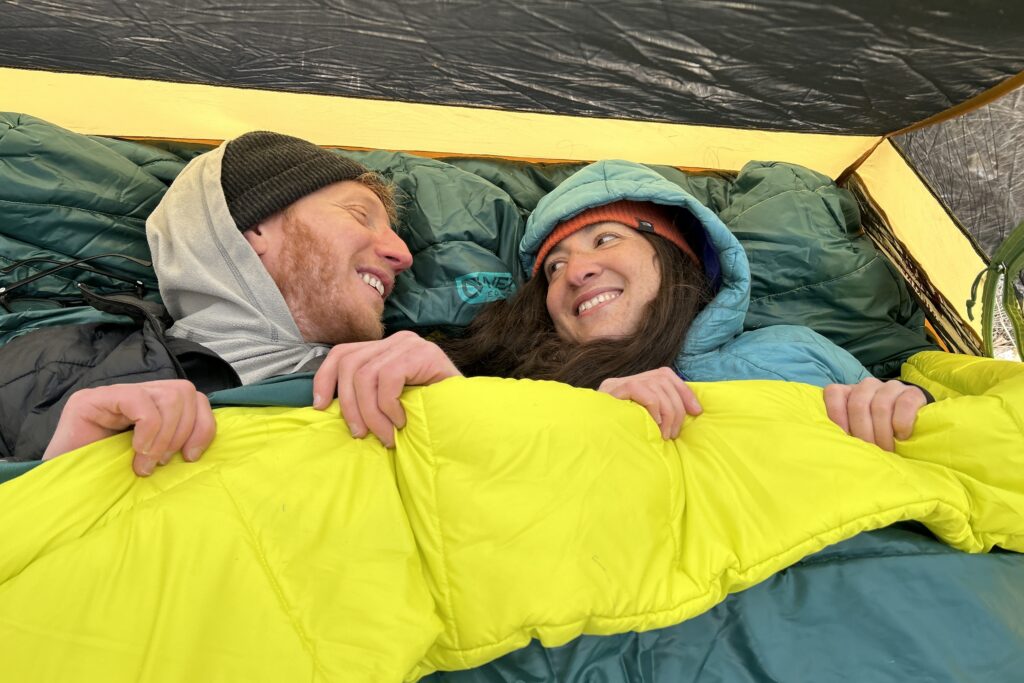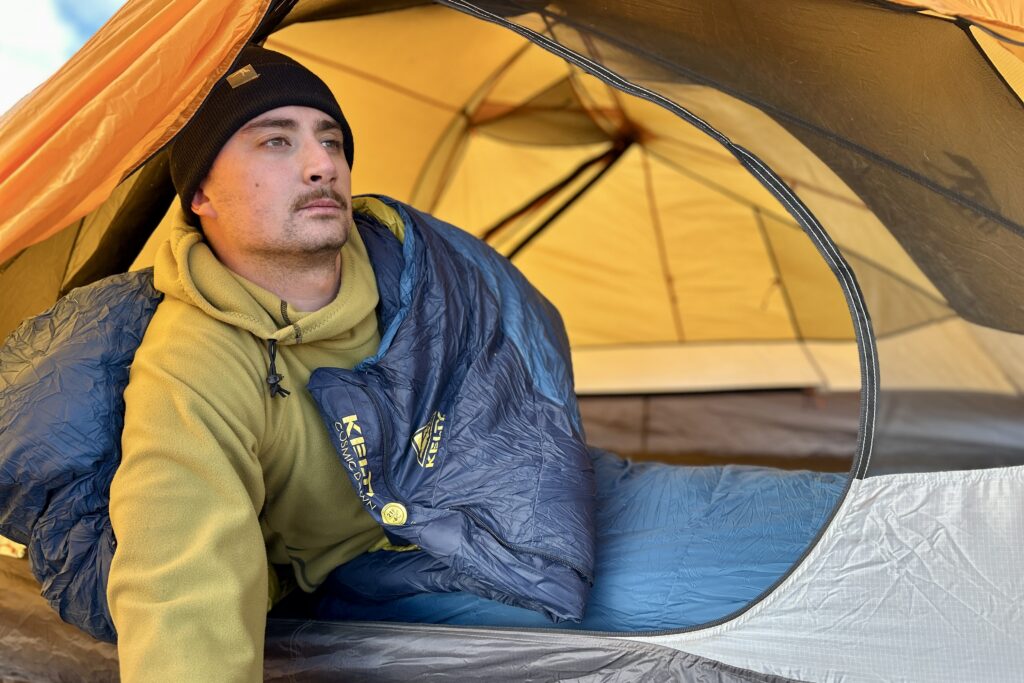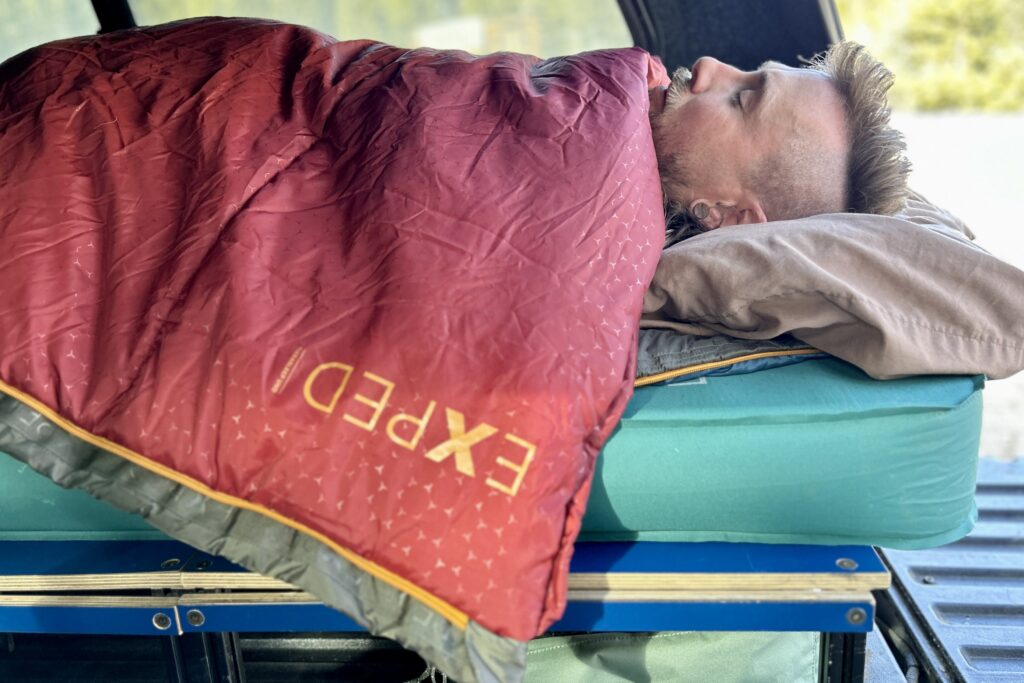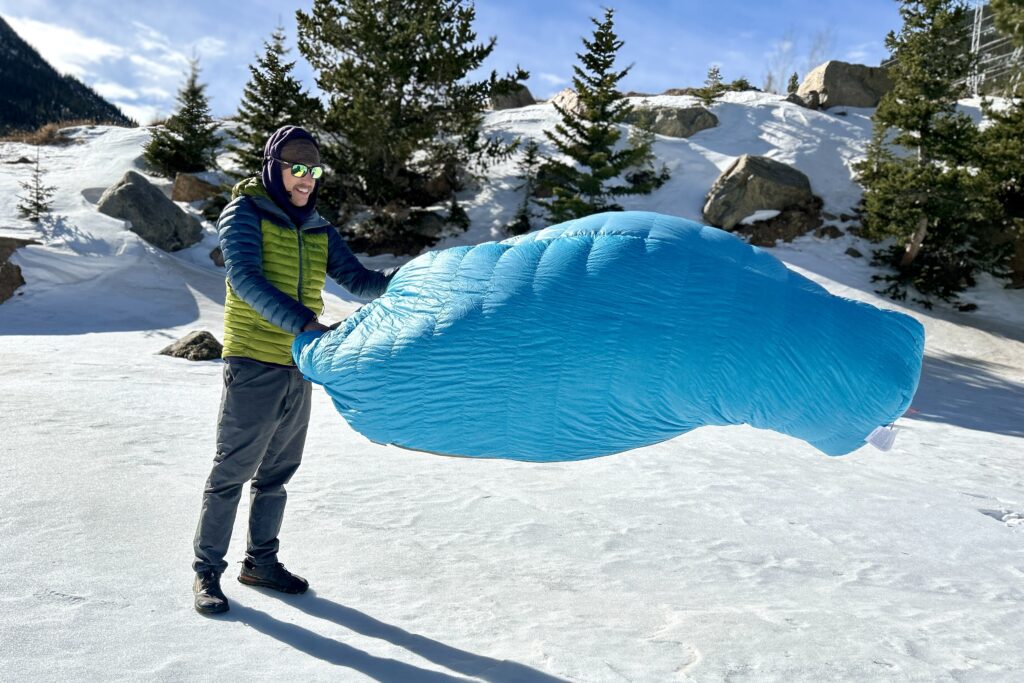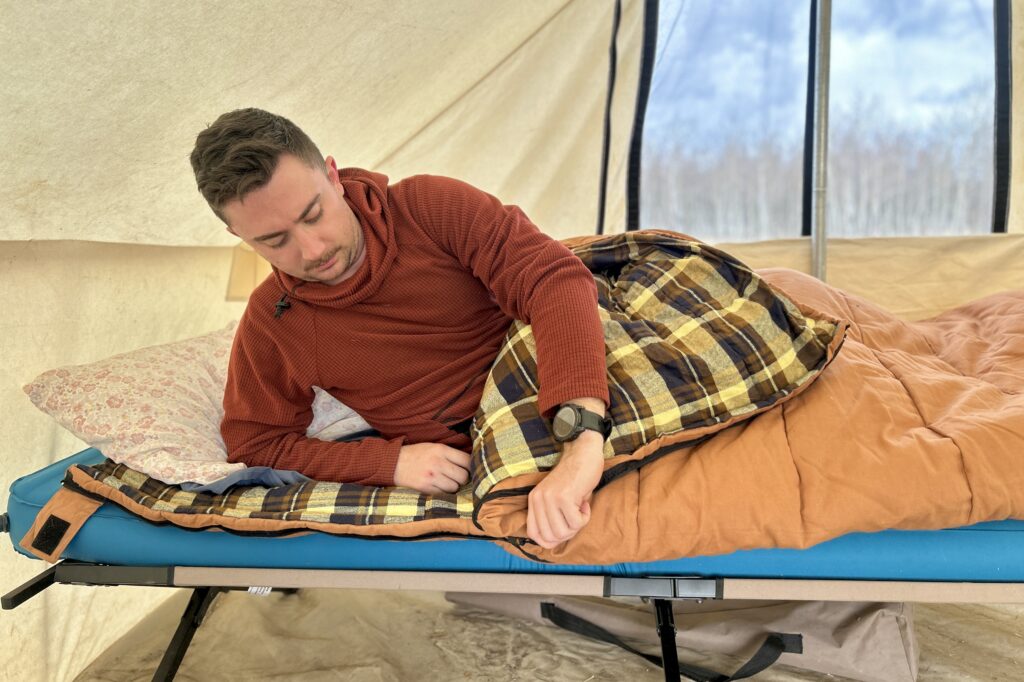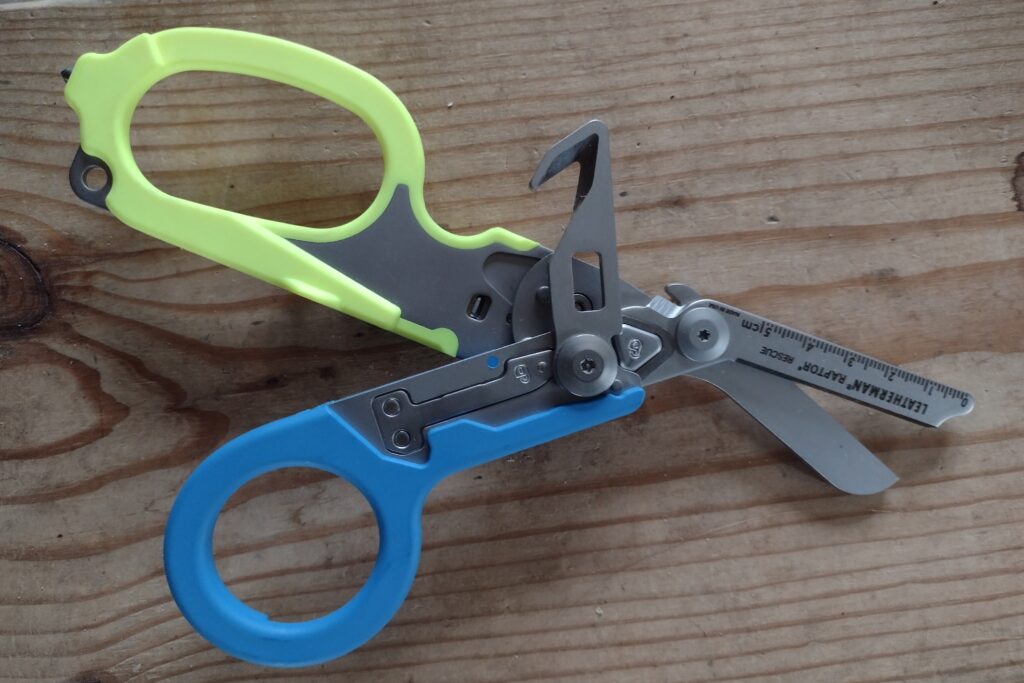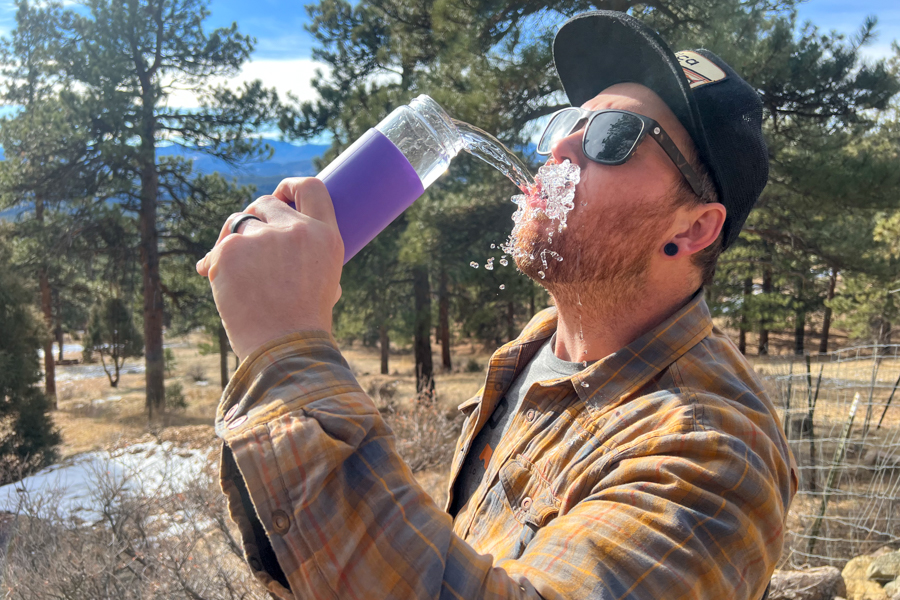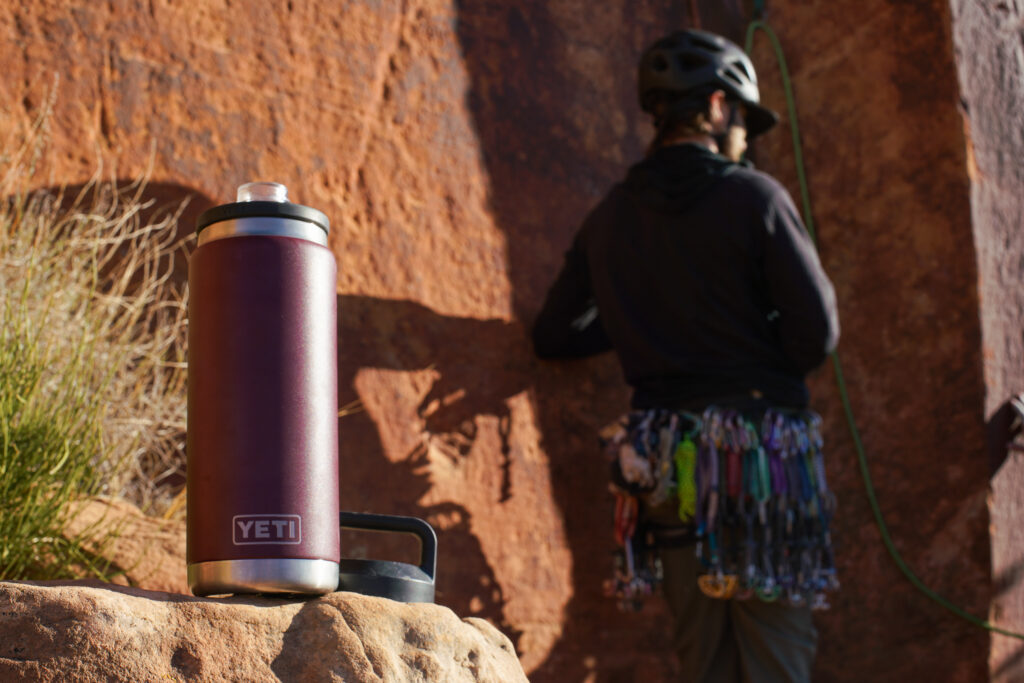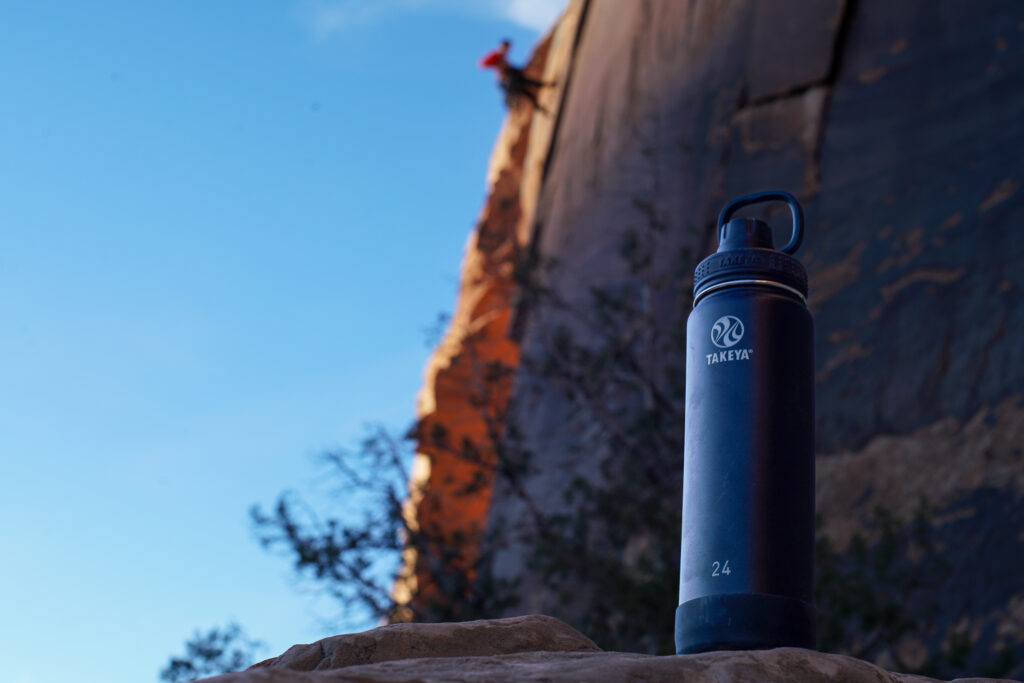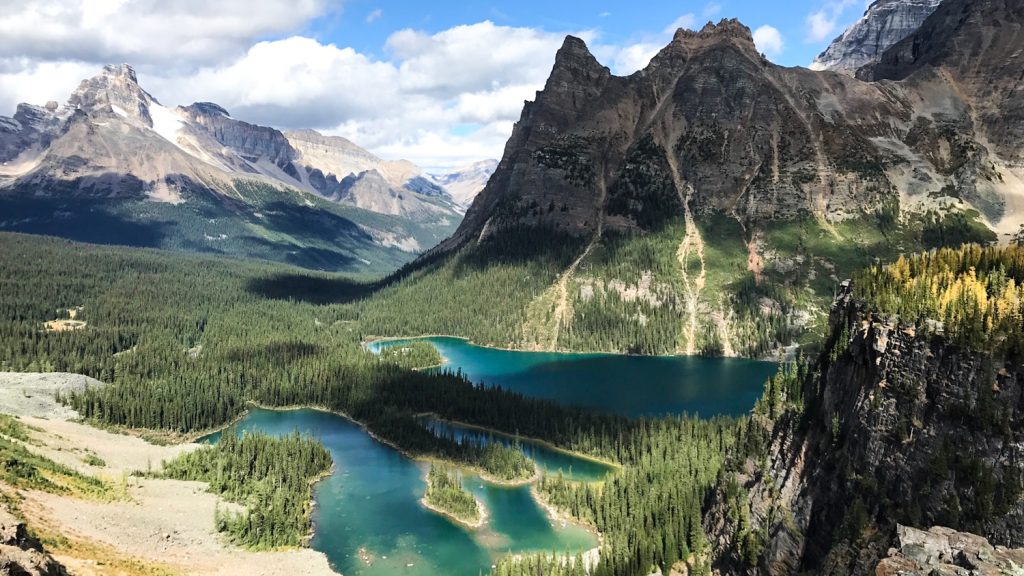
If we had to choose one location to illustrate the immense beauty of the Canadian Rockies, the Lake O’Hara backcountry would be the place. Eighty kilometers of well-maintained trails wind through this breathtaking alpine wilderness filled with turquoise lakes, stunning meadows, and expansive views. The Lake O’Hara backcountry, located in Yoho National park, is restricted to public use, which makes permits very hard to obtain, but also allows for relative solitude in this truly breathtaking wilderness. It’s no wonder the lovely Parks Canada rangers who are stationed at Lake O’Hara regard this place with such reverence. It’s truly remarkable and should be on every hiker’s bucket list.
Getting There
The Lake O’Hara backcountry is located in Yoho National Park in British Columbia, which is 13 km west of Lake Louise. The most sought after way to access the Lake O’Hara backcountry is by bus, which you pick up from the Lake O’Hara Parking Lot, but the bus reservation process is highly competitive (more info below). If you’re unable to secure a spot on the bus, you can hike 11km in on the road and take a bus back in the afternoon, but that method is far from ideal. Reservations for the return bus are not required, but you’ll need to bring cash for the one-way fee ($10 as of 2018).
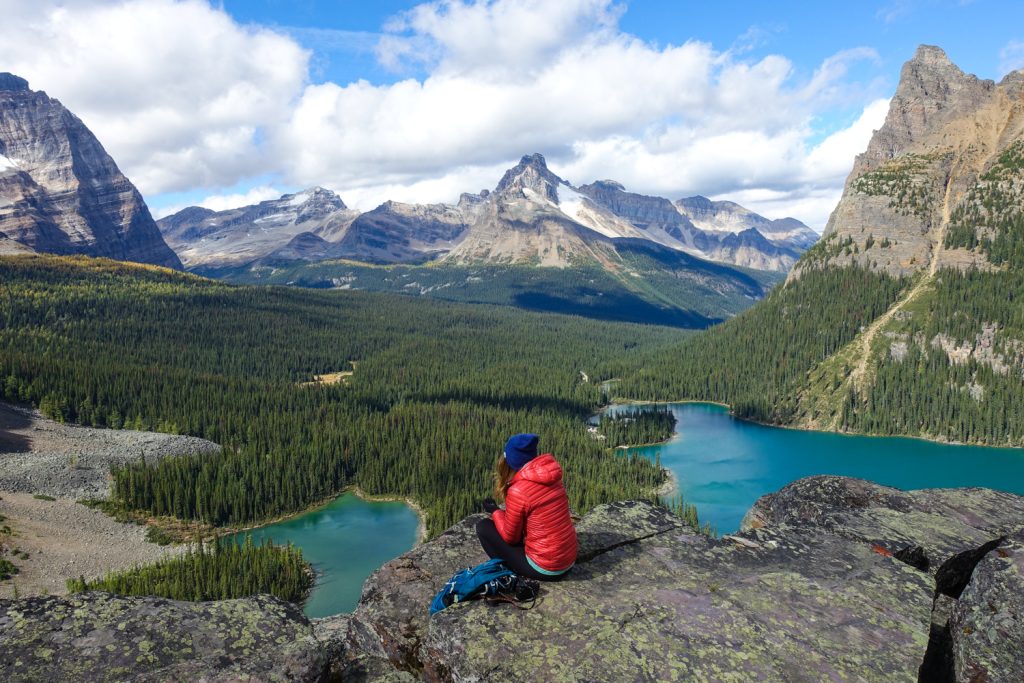
Planning Your Trip & Reservations
The Lake O’Hara area can be explored through a day-use permit or you can spend the night (campsite/hut/lodge) and hike around the park multiple days. There is a quota permit system in place to help protect this fragile alpine area which limits the bus service to 42 visitors per day, including overnight guests.
Day-Use Reservations
If you want a day-use bus permit for Lake O’Hara, you’ll need to be ready the first day (maybe even the first hour) permits open for the season. For 2018, the reservation system opens on April 20th at 8 am MDT.Day-use bus permits generally sell out within a couple hours. You can obtain a reservation by telephone (Canada and USA: 1-877-737-3783 or International 1-519-826-5391) or online through the Parks Canada Reservation System.
Not able to get a day-use reservation?
If you’re unable to secure a day-use reservation, there are a couple options. First, you can show up at the bus staging area and check in with a Parks Canada employee to be put on a wait list. If this option is unsuccessful, you can walk in along the 11 km access road. The route is not terribly grueling, nor is it scenic, it’s merely a way to get to the Lake O’Hara backcountry. If you are walking in, be sure to calculate this mileage into your day as you may not be able to cover as much trail. The good news is that you can take the outgoing bus without a reservation.
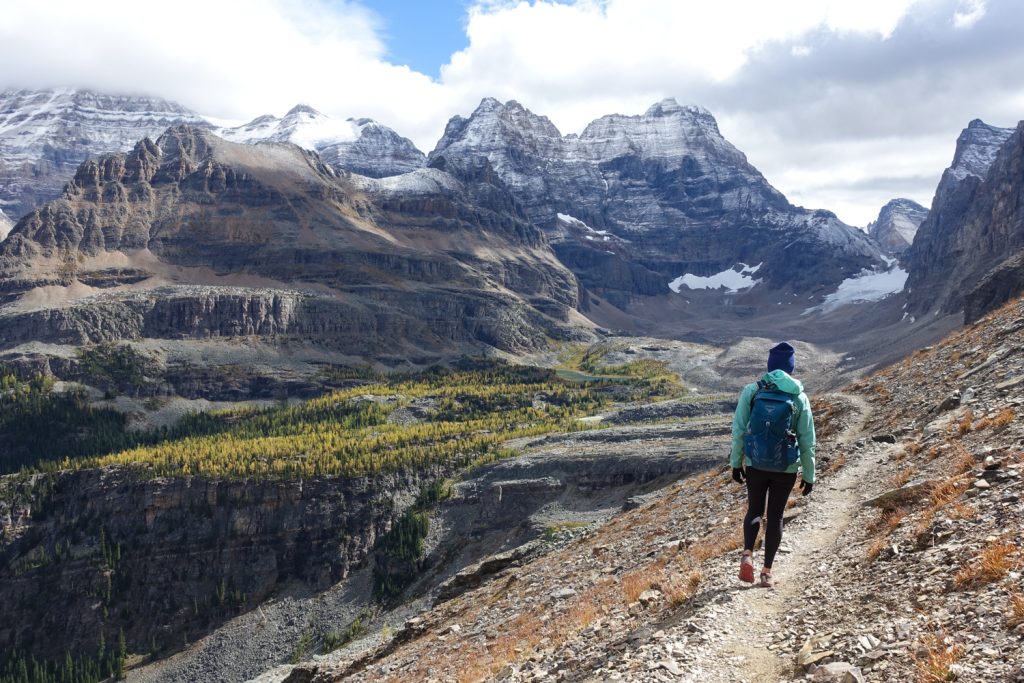
Camping or Lodge / Hut Reservations
Our recommended way to experience this truly breathtaking area is to spend multiple days exploring the trails. There are four overnight options, each with a different reservation system.
- Camp at the Lake O’Hara Campground
The campground at Lake O’Hara has 30 sites available. In order to obtain a camping reservation, you need to call the reservation system (1-250-343-6433) exactly three months before your anticipated date, beginning April 2nd for the 2018 season. Reservations are usually fully booked within a couple hours of opening. If you obtain a camping reservation, you are guaranteed a reserved spot on an ingoing bus.
You can book a maximum of three nights camping. When making your reservation, you are able to reserve up to two campsites with only one tent allowed at each site. More information regarding campground amenities can be found here.
- Stay at the Lake O’Hara Lodge
The most luxurious option for spending the night in the Lake O’Hara region is the lodge, which offers rooms in their main building as well as lakeshore cabins. It’s far from cheap, but you’ll be wined and dined in luxury. They also offer guided hikes around the region. Lake O’Hara Lodge runs its own shuttle service into the backcountry, which is included in your room rate.
- Stay at the Elizabeth Parker Hut
This backcountry hut is one of the most accessible and popular in Yoho, located in a beautiful meadow about 500 meters from Lake O’Hara. This rustic accommodation sleeps 24 in the summer. They provide sleeping pads, however you must bring your own sleeping bag. Reservations are highly competitive and must be made through a lottery system starting in October for the following summer. A reservation at the Elizabeth Parker Hut will include a reserved spot on an ingoing bus.
- Stay at the Abbot Pass Hut (advanced hikers only)
A stay at this historic stone hut (2nd highest permanent structure in Canada!) is a memorable experience, however should only be attempted by experienced hikers. To get there follow the trail to Lake Oesa and then climb 1,500 feet of difficult scree fields up a gully to the hut. According to Parks Canada, to attempt this route requires appropriate knowledge, equipment and safety precautions. Helmets are mandatory. To reserve a spot at the Abbot Pass Hut, which sleeps 24, you can make a reservation here. Because of the challenging route to the hut, it is not nearly as competitive to reserve as the Elizabeth Parker Hut. Similar to lodging options above, your reservation will include a reserved spot on an ingoing bus.
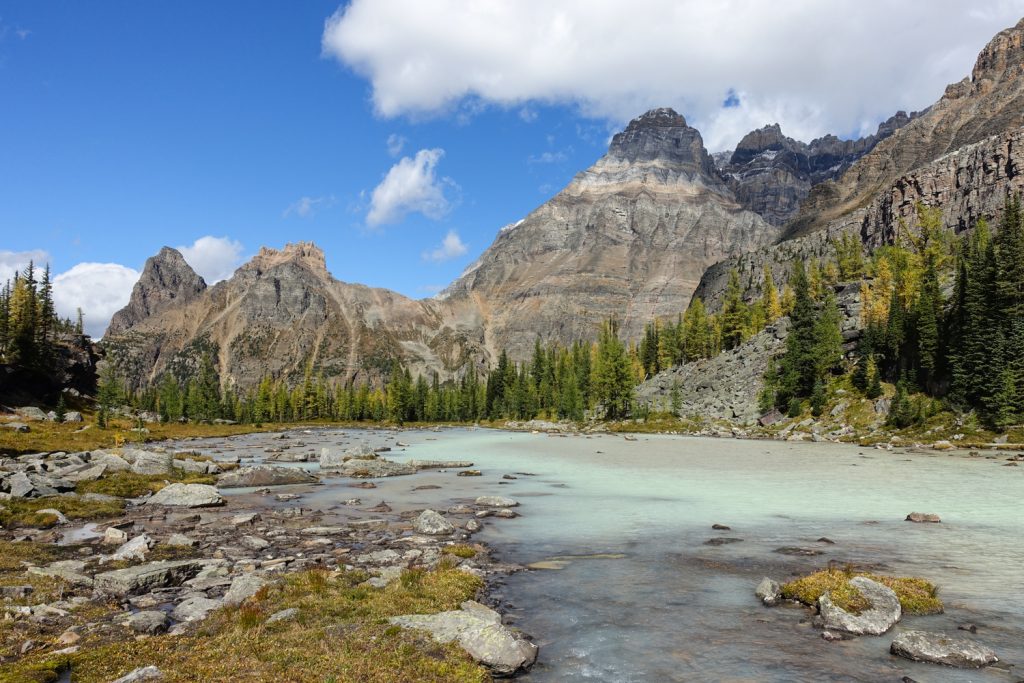
Bus Information
The ingoing bus staging area is near the parking lot under a small pavilion. There will be a Parks Canada employee who will check you in and answer any questions you may have. Arrive at the bus staging area 15-20 minutes before your anticipated departure time. When you get on the bus, you will be given a small green chip, which will be used as your outgoing bus ticket.
The outgoing bus staging area is in front of Le Relais Day Use Shelter. Again, arrive 15-20 minutes prior to your departure time. If you walked in, you will need to pay a one-way fee ($10 as of 2018) to get an outgoing bus. If you took the bus in, you will present your green chip to get on the bus.
To find the most up-to-date bus times and info, please visit the Parks Canada site.
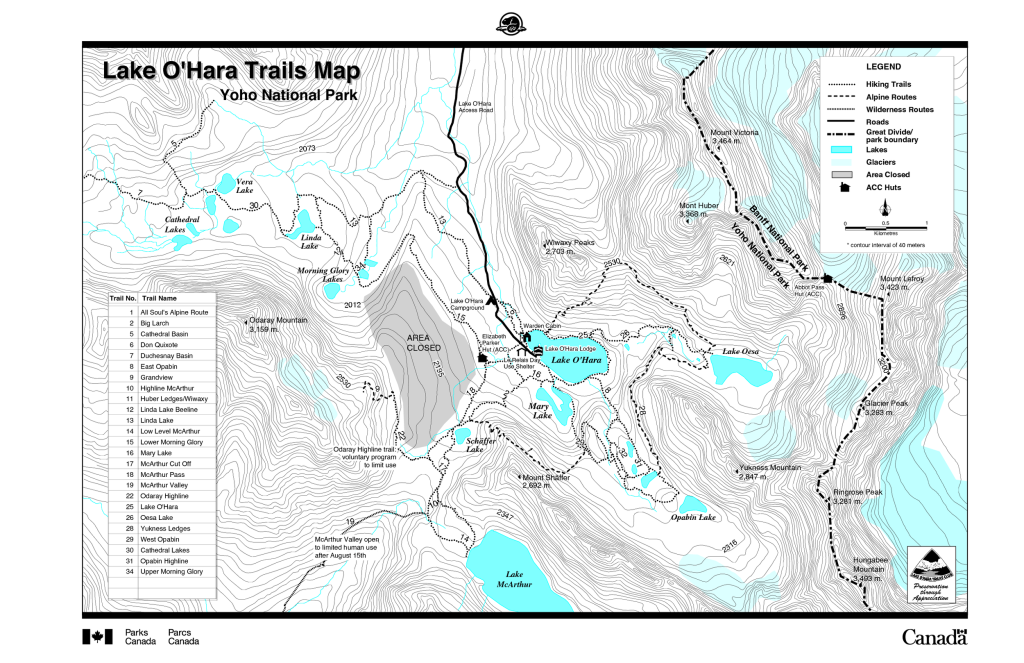
Possible Hiking Routes
The Parks Canada website has in-depth route descriptions for all the trails in the Lake O’Hara backcountry. Beyond the regular trail system, there are also five alpine routes in the Lake O’Hara area: Wiwaxy Gap, Huber Ledges, Yukness Ledges, All Soul’s Prospect, and the Odaray Grandview. These routes are for hikers who are experienced with mild route finding, comfortable with heights and are able to navigate exposed terrain. If you are looking for trails that are less strenuous than the alpine routes, there are over 80 km to choose from, offering a range of difficulty and length. Above is a map provided by Parks Canada to get a better idea of the trail system.
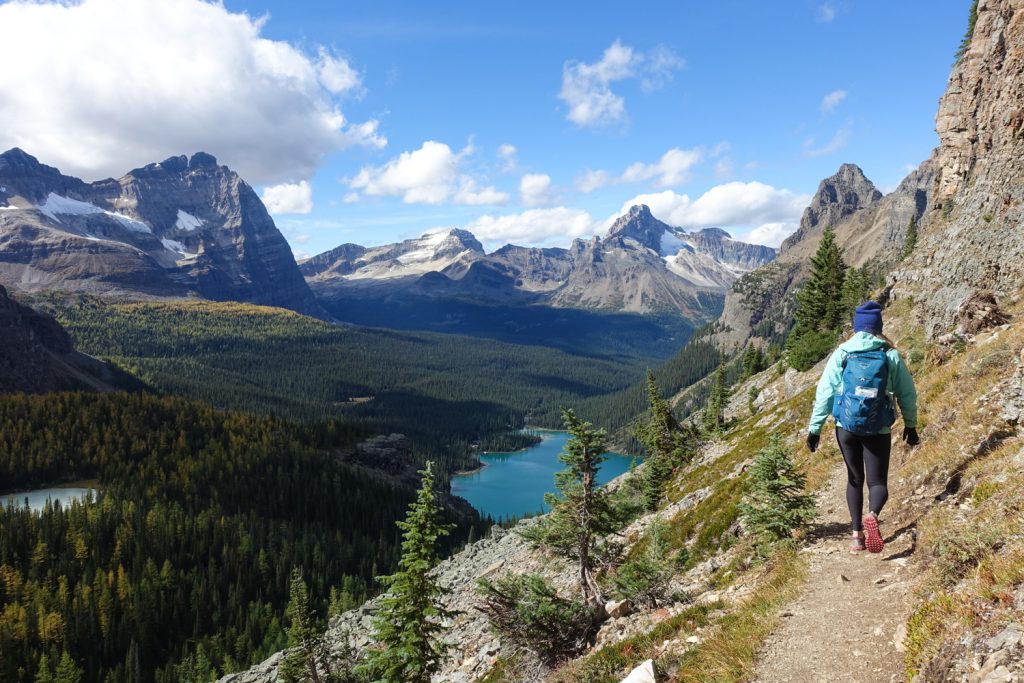
Alpine Circuit
- Length: 11.7 km (7.3 miles)
- Elevation Gain: 1051 meters (3,448 feet)
- Estimated Time: 5-8 hours
Description: If you only have one day and are up to the challenge, the alpine circuit is the gem of the Lake O’Hara region. This spectacularly scenic loop covers a lot of ground and traverses the exposed, but incredible Huber and Yukness Ledges. Along the way you will pass a handful of small scenic lakes and streams, visit Lake Oesa and the Opabin Plateau, and climb to the viewpoint from the Wiwaxy Gap. The scenery is ever-changing and stunning from every angle.
*The Huber and Yukness Ledges have some areas that are steep and exposed. Those with a fear of heights may not enjoy these portions, though we feel the route is safe if you watch your step. The entire alpine route is well-marked with blue and yellow blazes.
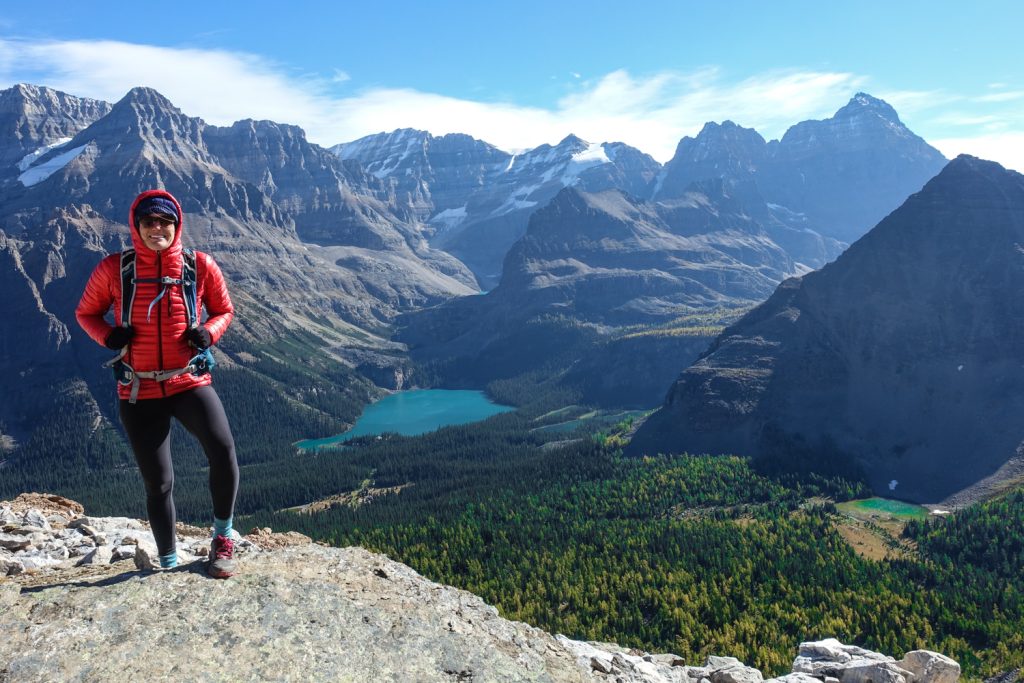
Odaray Highline to Odaray Grandview
- Length: 2.4 km (1.5 miles) out and back from the McArthur Pass Trail junction
- Elevation Gain: 90 meters (300 feet)
- Estimated Time: 2-3 hours
Description: This hike offers one of the most expansive views in the park, giving you the widespread vantage point of Lake O’Hara and impressive Lake McArthur. It’s a steep scramble to the top, but well worth it for the view. In order to hike this portion of trail, you will need to arrive at the junction with the Odaray Highline from the Lake McArthur trail before the daily limit of groups has been reached. There is a voluntary program in place which restricts this area to two groups per day in order to protect an important wildlife corridor. Please respect this policy.
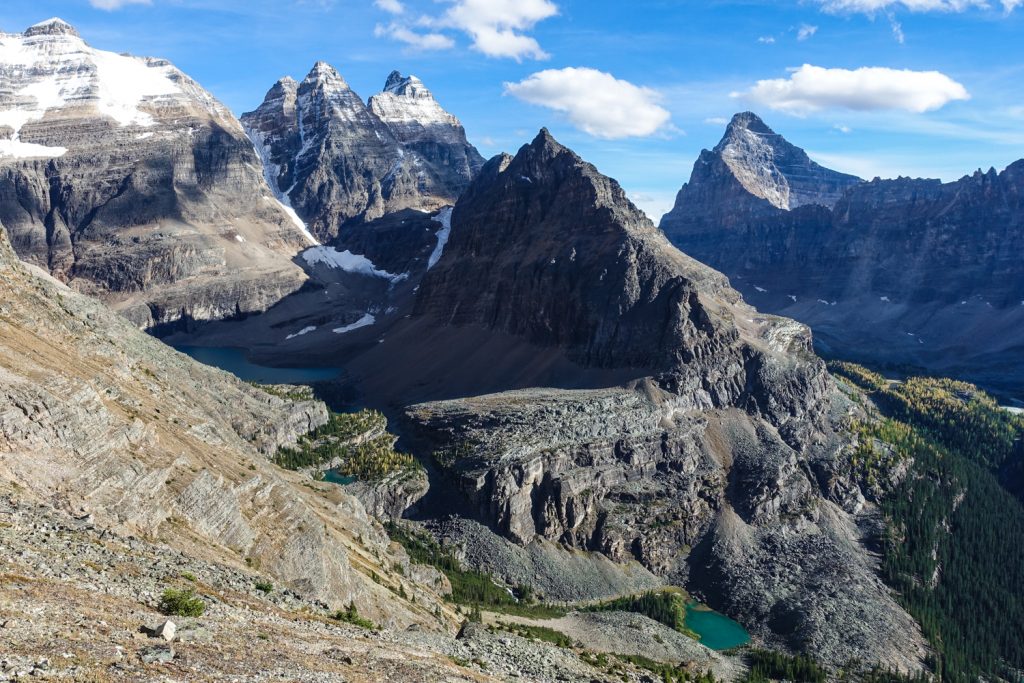
Lake Oesa Trail
- Length: 6.4 km (4 miles) out and back
- Elevation Gain: 240 meters (800 feet)
- Estimated Time: 2-4 hours
Description: If you are only completing one trail and don’t have the time or stamina to do the Alpine Circuit, we recommend the Lake Oesa Trail. This trail traverses scree slopes, rocky outcrops and delicate meadows as it ascends to gorgeous Lake Oesa. You can retrace your steps back to Lake O’Hara or you could make a loop through the Huber Ledges to the Opabin Plateau, if you have the time and are comfortable with mild exposure.
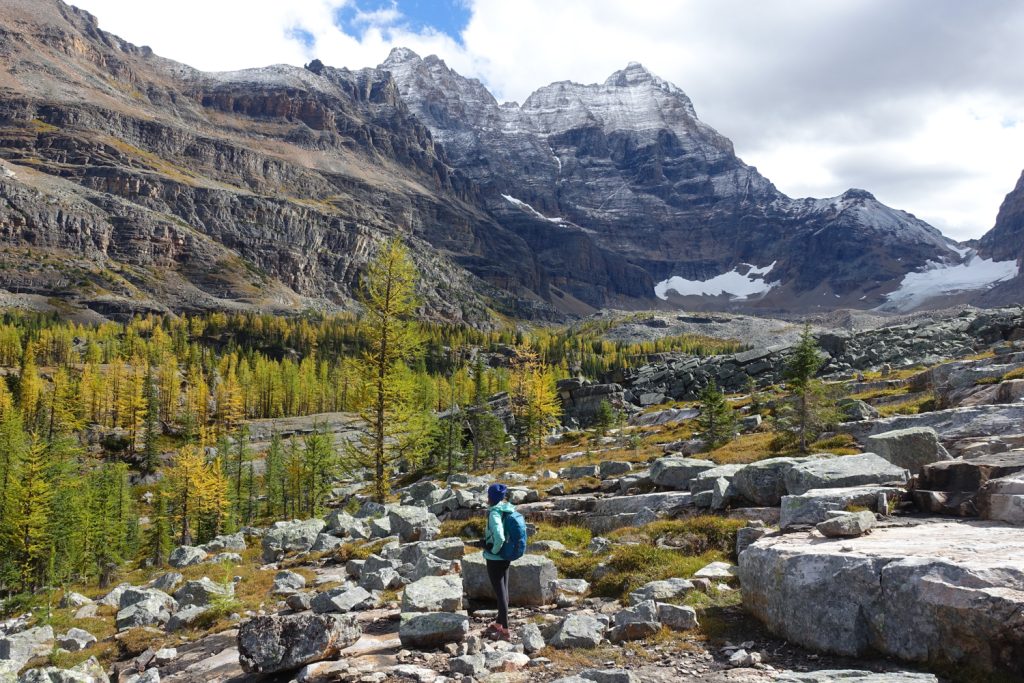
Opabin Plateau Circuit
- Length: 5.9 km (3.7 miles)
- Elevation Gain: 250 metres (820 feet)
- Estimated Time: 2-4 hours
Description: The Opabin Plateau is a truly stunning area that is not to be missed in the Lake O’Hara region. You can complete a lollipop loop with both the West and East Opabin Trails once you climb the talus slopes past Mary Lake. The Opabin Plateau Circuit climbs into a beautiful meadow filled with milky aqua streams and lakes along a grassy, rolling terrain. Opabin Lake is a beautiful alpine lake nestled on all sides by commanding mountains and glaciers. On your way out, don’t miss a side trail that leads to the Opabin Prospect for the quintessential photo opportunity of Mary Lake and Lake O’Hara.
Lake O’Hara Shoreline Trail
- Length: 2.8 km (1.7 miles)
- Elevation Gain: minimal ups and downs
- Estimated Time: 1-2 hours
Description: This hike is a beautiful and easy stroll around pristine Lake O’Hara. On this loop you’ll also pass lovely Seven Veil Falls. This straightforward option may be a good choice for those with little time or those looking for an easier hike.
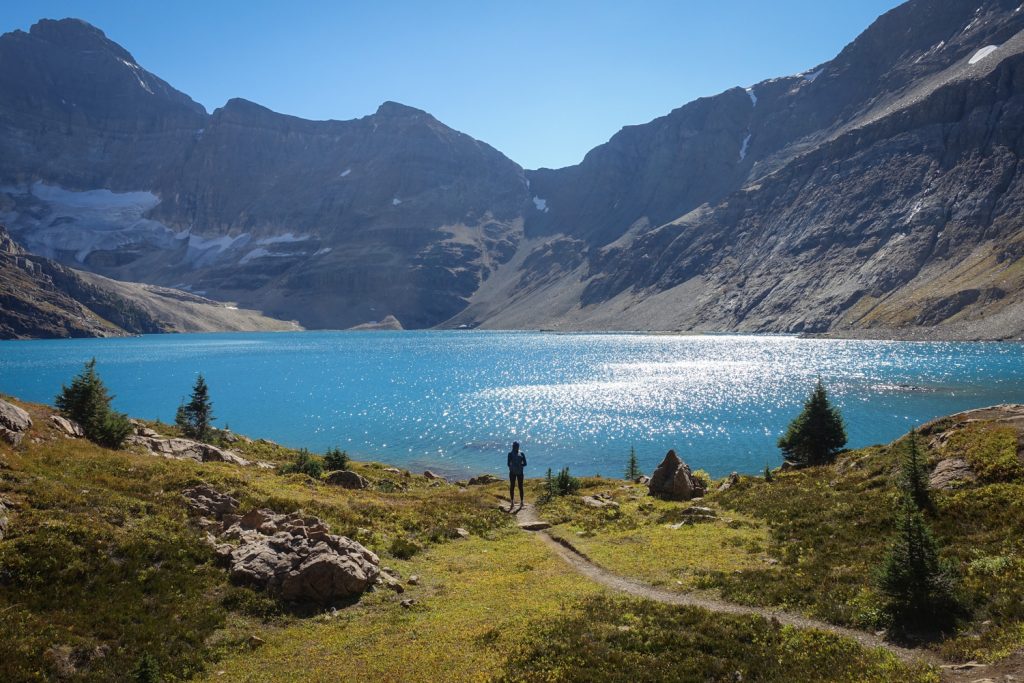
McArthur Pass and Lake McArthur trails
- Length : 8 km (5 miles)
- Elevation Gain : 310 meters (1,000 feet)
- Estimated Time: 2-4 hours
Description: This trail to the large, jewel blue McArthur Lake is tucked away in its own valley and is a beauty to behold. You can make a minor loop hike by hiking up the west branch and returning via the east branch. You’ll also hike past the small, but charming Shaffer Lake along the way. If you get the chance to hike the Odaray Highline, it’s easy to combine these two routes into a day hike.
Linda Lake Circuit and Morning Glory Lakes
- Distance: 7 km (4.3 miles)
- Elevation Gain: 140 metres (460 feet)
- Estimated Time: 2-4 hours
Description: This pleasant and relatively easy hike will bring you to several beautiful backcountry lakes. You’ll pass the Elizabeth Parker hut along the way as you travel through meadows and forest. This is a great option if you have several days in the backcountry and want to explore a less-visited and more secluded area of Lake O’Hara.

What Do I Need To Pack?
Most people access the Lake O’Hara backcountry via bus and set up a base camp. Although you won’t have to hike all your gear in, you still want to pack as if you’re backpacking, with maybe a few extra luxury items.
Parks Canada has a few equipment restrictions in place:
- Baggage is restricted to two small bags per person (max weight: 25 kg / 55 lbs; max length 97 cm / 38”)
- Hard sided food coolers, storage bins, plastic bags, and loose items are not permitted on the bus. Please leave musical instruments, electronics, chairs and hammocks behind.
- Be sure to bring a backpacking stove for cooking. The wood stoves and fire pits are best used for heat.
DAY HIKING GEAR CHECKLIST
DAYPACK – We love the lightweight Osprey Talon 22 and REI Flash 22 daypacks. They’re very comfortable and just about the perfect size for a long day hike.
SHOES OR BOOTS – We almost always prefer trail runners when hiking. We wore Saucony Peregrine 7 trail runners, which come in both male and female versions, and they were great. If you prefer boots, make sure they’re lightweight and break them in really well before you set off on the trail. Here’s why we prefer hiking in trail running shoes: 5 Reasons to Ditch Your Hiking Boots.
WATER PURIFIER – If you are staying at the campground, there will be treated water provided for you. However, while you are out hiking you will want to ensure you have plenty or water or a lightweight purifier to fill up your bottles. We recommend carrying two 1L plastic water bottles per person. We love using the SteriPEN Ultra in clear water and would highly recommend it. It’s fast, easy, and effective.
BEAR SPRAY – Lake O’Hara is home to a healthy grizzly and black bear population. You should always hike with bear spray and know how to use it properly. We recommend reading Parks Canada in-depth information on Bears and People as you prepare for your trip.
FOOD – You’ll want to pack snacks for the day, as well as an adequate lunch. For some suggestions on food to pack for backpacking and hiking, check out our video on Backpacking Food.
CLOTHING
Here are some of our favorite hiking/backpacking clothing items from our Top Gear list.
- 1 Rain jacket shell – Patagonia M10 / Rab Kinetic Plus
- 1 Pair rain pants – Mountain Hardwear Stretch Ozonic
- 1 Down jacket – Patagonia Ultralight Down Hoody
- 1 Fleece jacket – Extra warmth under your down jacket that will be warmer when damp and better to hike in.
- 1 Pair hiking pants / running tights
- 1 Pair hiking shorts – Nike dri fit running shorts
- 1-2 Hiking t-shirts – Nike dri fit t-shirts
- 1 Long-sleeve shirt – Nike dri fit quarter zip
- 1-3 Pair underwear – ExOfficio boxer briefs or ExOfficio women’s briefs
- 2-3 Pair socks (add thin sock liners if using boots) – Balega running socks for warm weather & SmartWool mountaineer socks for snow.
- 1 Pair long john bottoms – long john top optional for nighttime use.
- 1 Warm hat
- 1 Sun hat
- 1 Pair gloves or mittens
MAP, COMPASS & GUIDEBOOK – We used this Lake Louise and Yoho Map, which provided great descriptions of trails and milage. There is also a specific map to the Lake O’Hara area. We always hike with a compass too, though the trails were easy to follow and we didn’t end up needing it. We also used the Lonely Planet guidebook to help us plan out our entire trip in the Canadian Rockies and found it very helpful.
FIRST-AID KIT – Always bring a small personalized first aid kit. We used the .5 Ultralight Kit and added extras, like painkillers and personal medications.
SUN PROTECTION – Sunglasses (polarized recommended), sunscreen, and spf lip balm are an absolute must.
POCKET KNIFE – We brought along a small Swiss Army Knife which came in handy here and there. This should be considered optional, but we like to hike with one.
PACK COVER – We don’t hike with pack covers because they don’t provide full rain protection. We use a combination of waterproof stuff sacks and a sturdy trash bag liner inside our packs. That gives us 100% rain protection, even in a downpour. Ziploc bags also come in handy.
OTHER ITEMS:
- SMALL TOWEL – the Nano pack towel is great.
- CASH and ID
- PERMITS
- PERSONAL TOILETRIES
- HAND SANITIZER – Always apply after using a bathroom and before eating.
- WET WIPES – These are useful for cleaning up after hiking.
- INSECT REPELLANT – At higher elevations insects aren’t a problem at all. For lower elevations, 30% DEET will do the trick. In fall we didn’t use any.
- CAMERA – The Sony RX100 is our go-to camera for backpacking.
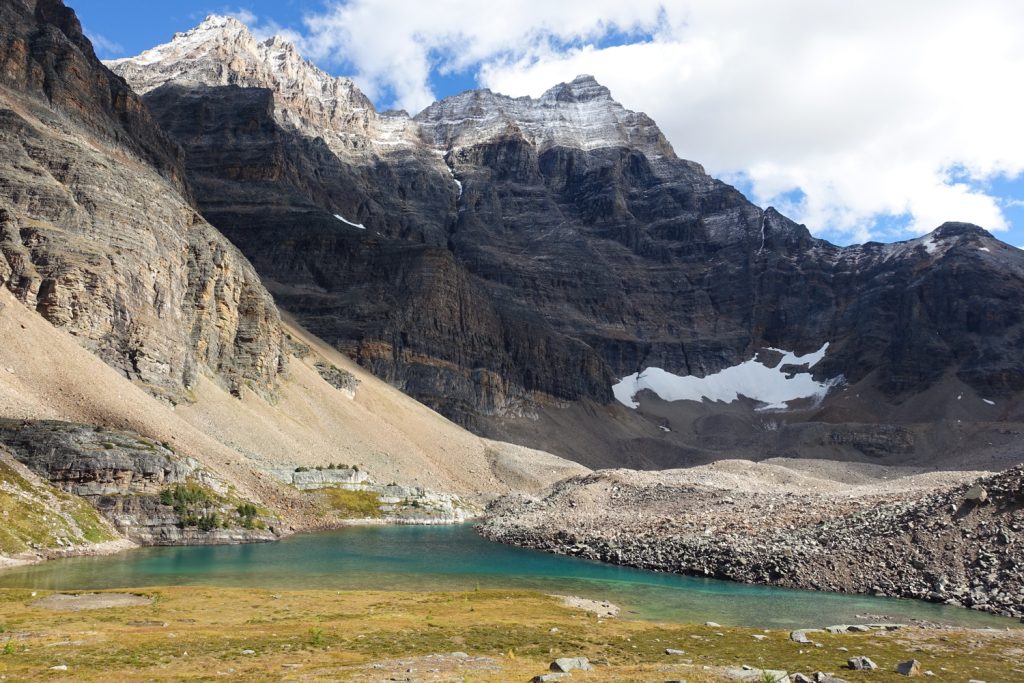
Additional Gear For Camping
BACKPACK: We used the HMG 2400 Southwest and GG Gorilla backpacks on this trek. Both are lightweight, convenient, comfortable, and make our list of the best lightweight backpacking packs.
SLEEPING BAG – We used the Feathered Friends Egret UL 20 Sleeping Bag and REI Magma 10 sleeping bags. Both are lightweight and incredibly warm. Here’s a list of some of our other favorite lightweight sleeping bags.
SLEEPING PAD – We recommend a lightweight sleeping pad like the Therm-a-Rest NeoAir XLite to keep you warm and ensure a good night’s rest. Here’s a list of our favorite sleeping pads.
TENT – We always hike with a durable, but lightweight tent. Here are some of our favorite tents of the year.
COOKING SYSTEM – We love the JetBoil MiniMo as a backcountry stove that’s easy to use and compact. We also like compact canister stoves like the MSR Pocket Rocket.
HEADLAMP – A small headlamp like the Petzl Actik will be useful for late night bathroom visits.
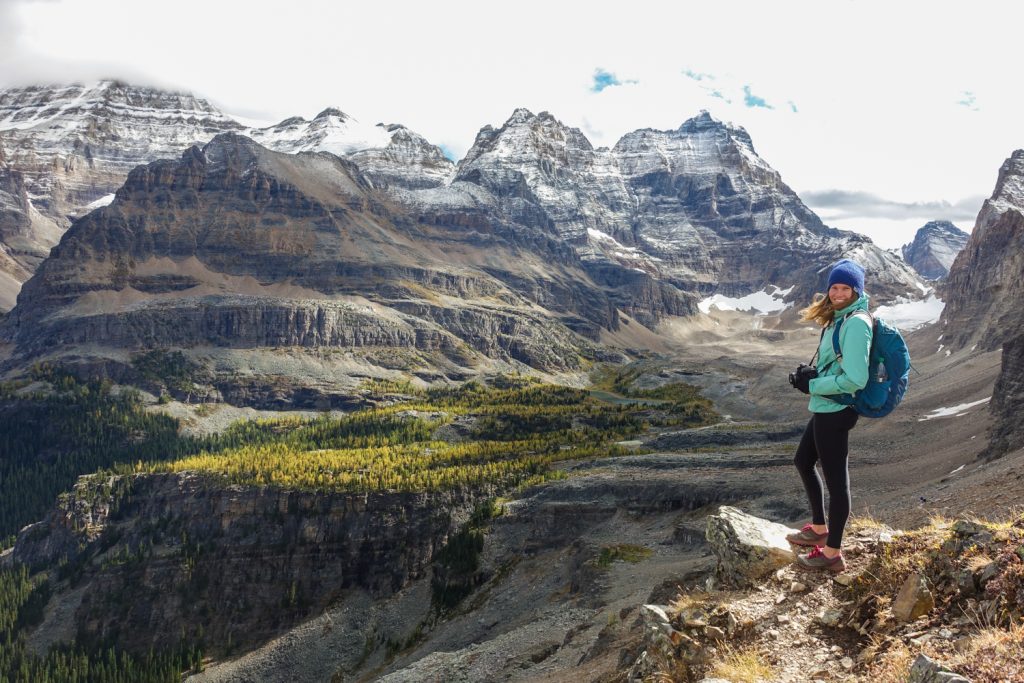
Do Your Part: Protect and Preserve
The Lake O’Hara alpine environment is an incredibly fragile and sensitive environment. Please do your part to help protect and preserve this incredibly special place. Parks Canada asks that you strongly follow these guidelines:
- Respect wildlife – Do not feed or approach wildlife, and please carry bear spray. Read the Bears and People brochure for more information about bear safety.
- Leave no trace – Be sure to pack out all garbage including food waste, diapers, tampons, sanitary napkins and toilet paper.
- Stay on the trails – This helps minimize trail braiding, trampling and erosion.
- Let it be – Please leave natural and historical objects in their natural setting for others to discover and enjoy.
- Respect warnings, closures and seasonal restrictions. Research has identified important grizzly bear habitat and a regional wildlife corridor in the area
- Be safe – As always, your safety is your responsibility.

